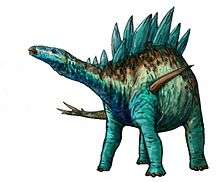Struthiosaurus
| Struthiosaurus Temporal range: Late Cretaceous, 85–66 Ma | |
|---|---|
| | |
| Struthiosaurus humerus | |
| Scientific classification | |
| Kingdom: | Animalia |
| Phylum: | Chordata |
| Class: | Reptilia |
| Clade: | Dinosauria |
| Order: | †Ornithischia |
| Family: | †Nodosauridae |
| Subfamily: | †Struthiosaurinae |
| Genus: | †Struthiosaurus Bunzel, 1871 |
| Type species | |
| †Struthiosaurus austriacus Bunzel, 1871 | |
| Species | |
| Synonyms | |
| |
Struthiosaurus (Latin struthio = ostrich + Greek sauros = lizard) is one of the smallest known and most basal genera of nodosaurid dinosaurs, from the Late Cretaceous period (Campanian-Maastrichtian) of Austria, Romania and France in Europe.[1] It was protected by body armour. Although estimates of its length vary, it may have been as small as 2.2 metres (7.2 ft) long.
Taxonomy and valid species
Originally described in 1871 by Emanuel Bunzel,[2] after remains uncovered by Eduard Suess and Ferdinand Stoliczka in 1855 from the Gute Hoffnung coal mine at Muthmannsdorf near Wiener Neustadt in Austria. Many species have been referred to Struthiosaurus, most based on very fragmentary and nondiagnostic material. Three valid species are recognized by paleontologists: S. austriacus Bunzel, 1871, based on holotype PIWU 2349/6; S. transylvanicus Nopcsa, 1915, based on BMNH R4966, a skull and partial skeleton from Romania;[3] and S. languedocensis Garcia and Pereda-Suberbiola, 2003, based on UM2 OLV-D50 A–G CV, a partial skeleton found in 1998 in France.[4] It is the namesake of the nodosaurid subfamily Struthiosaurinae, members of which are found only in Europe.[5]

A number of invalid taxa have been shown to be junior synonyms of Struthiosaurus austriacus, most of them created when Harry Govier Seeley in 1881 revised the Austrian material.[6] They include: Danubiosaurus anceps Bunzel, 1871; Crataeomus pawlowitschii Seeley, 1881; Crataeomus lepidophorus Seeley 1881; Pleuropeltis suessii Seeley, 1881; Rhadinosaurus alcimus Seeley 1881, Hoplosaurus ischyrus Seeley 1881 and Leipsanosaurus noricus Nopcsa, 1918.[7] Another European ankylosaurid, Rhodanosaurus ludguensis Nopsca, 1929, from Campanian-Maastrichtian-age rocks of southern France, is now regarded as a nomen dubium and referred to Nodosauridae incertae sedis.[8]
The three valid species of Struthiosaurus differ from one another in that S. austriacus is smaller than S. transylvanicus and possesses less elongate cervical vertebrae. Also, though the quadrate-paroccipital process contact is fused in S. transylvanicus, it is unfused in S. austriacus. The skull of S. languedocensis is unknown, but the taxon differs from S. transylvanicus in the flatter shape of the dorsal vertebrae. It differs from S. austriacus in the shape of the ischium. (Vickaryous, Maryanska, and Weishampel 2004)
Phylogeny

Struthiosaurus was originally by Bunzel considered a predator that he assigned to the new taxon Ornithocephala ("Bird Heads"). The generic name is a reference to the affinities with birds shown by traits in the skull. The first to understand it represented an armoured dinosaur was Nopcsa who in 1902 placed it in the Acanthopholididae.[9] He later corrected its name to Acanthopholidae.[10] Walter Coombs in 1978 stated it was a nodosaurid.[11]
Cladistic analysis of Struthiosaurus (Ösi, 2005) indicates that the taxon is a basal member of the Nodosauridae and suggests it may be one of the most basal ankylosaurs in the clade Ankylosauria.
See also
References
- ↑ Struthiosaurus in The Dinosaur Encyclopaedia at Dino Russ's Lair
- ↑ Bunzel, E. 1871. Die Reptilfauna der Gosaformation in der Neuen Welt bei Wiener-Neustadt. Abhandlungen der Kaiserlich-Königlichen Geologischen Reichsanstalt. Wien 5:1-18
- ↑ F. Nopcsa, 1915, "Die dinosaurier der Siebenbürgischen landesteile Ungarns", Mitteilungen aus dem Jahrbuche der Königlich-Ungarischen Geologischen Reichsanstalt 23: 1-24
- ↑ G. Garcia and X. Pereda-Suberbiola, 2003, "A new species of Struthiosaurus (Dinosauria: Ankylosauria) from the Upper Cretaceous of Villeveyrac (southern France)", Journal of Vertebrate Paleontology 23(1): 156-165
- ↑ Kirkland, J. I.; Alcalá, L.; Loewen, M. A.; Espílez, E.; Mampel, L.; Wiersma, J. P. (2013). Butler, Richard J, ed. "The Basal Nodosaurid Ankylosaur Europelta carbonensis n. gen., n. sp. From the Lower Cretaceous (Lower Albian) Escucha Formation of Northeastern Spain". PLoS ONE 8 (12): e80405.
- ↑ H.G. Seeley, 1881, "The reptile fauna of the Gosau Formation preserved in the Geological Museum of the University of Vienna", Quarterly Journal of the Geological Society of London 37(148): 620-707
- ↑ F. Nopcsa, 1918, "Leipsanosaurus n. gen. ein neuer thyreophore aus der Gosau", Földtani Közlöny 48: 324-328
- ↑ Pereda-Suberbiola, X., and Galton, P. M., 2001. Reappraisal of the nodosaurid ankylosaur Struthiosaurus austriacus Bunzel, 1871 from the Upper Cretaceous Gosau Beds of Austria. pp. 173-210 In: Carpenter, K., (ed.) The Armored Dinosaurs. Indiana University Press, Bloomington & Indianapolis, 2001, pp. xv-526
- ↑ F. Nopcsa. 1902. "Notizen über cretacische Dinosaurier". Sitzungsberichte der Mathematisch-Naturwissenschaftlichen Classe der Kaiserlichen Akademie der Wissenschaften III(1): 93-114
- ↑ Nopcsa, B.F. (1928). "Palaeontological notes on reptiles. V. On the skull of the Upper Cretaceous dinosaur Euoplocephalus". Geologica Hungarica, Series Palaeontologica. 1 (1): 1–84.
- ↑ W.P. Coombs. 1978. "Forelimb muscles of the Ankylosauria (Reptilia, Ornithischia)". Journal of Paleontology 52(3): 642-657

